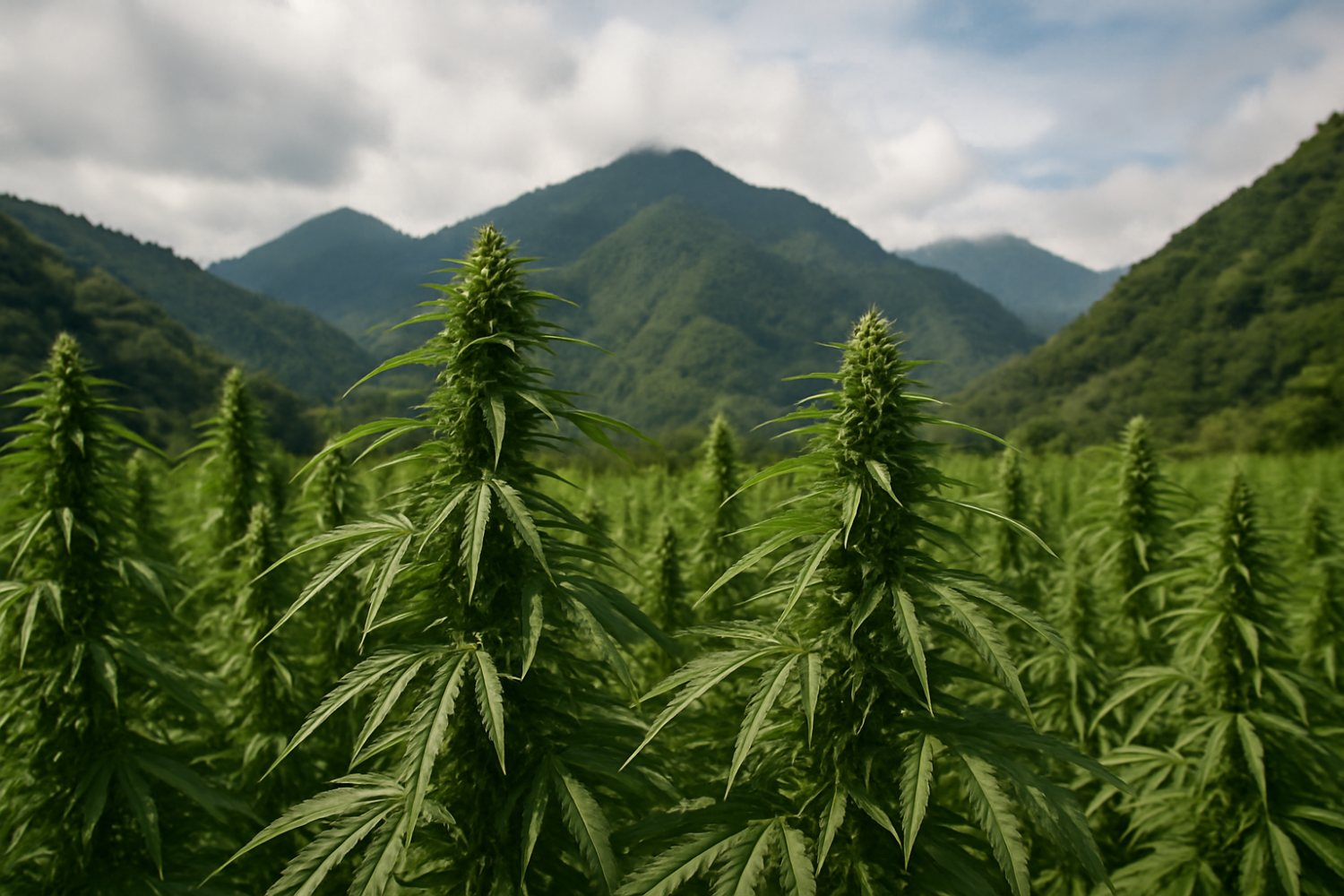Cannabis in Colombia has a culture that runs deep — way deeper than most people realize. For generations, this country’s soil has grown some of the richest, most naturally perfect plants on the planet. Long before legalization, farmers in small mountain towns were quietly cultivating medicine and culture at the same time.
Today, Colombia stands at a turning point. What used to be criminalized is now licensed. What was once grown in secret is now exported across oceans. From the Andes to the Caribbean coast, a new generation of growers, scientists, and community leaders is flipping the script — turning decades of stigma into one of the world’s most promising legal cannabis markets.
This is the full breakdown on what’s happening with cannabis in Colombia — the laws, the people, the culture, the farms, the tourism, and the big shift that’s turning “weed country” into a symbol of recovery and pride.
Cannabis in Colombia: From Prohibition to Progress
For decades, Colombia’s name got tied to a global drug war that had nothing to do with the plant itself. The cannabis grown here wasn’t cartel weed — it was an agricultural product that ended up lumped into a bigger story of cocaine and chaos. But in rural communities, especially along the Caribbean and Pacific coasts, families used cannabis as medicine, for fibers, and even for spiritual rituals.
Then came prohibition. The 1980s and ‘90s brought harsh laws, prison time, and decades of fear. Cannabis was banned outright. Farmers who had nothing to do with international trafficking were punished just for growing.
But times changed. In 2016, Colombia legalized medical cannabis.
That single law — Law 1787 — opened the door for hundreds of farmers and entrepreneurs to step into the light.
It gave hope to regions that had been hit hardest by conflict, and it gave a legal framework to an industry that had always existed, just underground.
Cannabis in Colombia Is Legal — Kind Of
Here’s how it works in 2025:
- Medical cannabis is legal and fully regulated.
- Cannabis flower can be grown and exported for medical and scientific use.
- Recreational cannabis is still illegal, but personal use and small home grows (up to 20 plants) are decriminalized.
- CBD and hemp are legal and thriving industries.
Cannabis in Colombia runs through a few key government agencies:
- INVIMA – handles health regulations and product approvals.
- Ministry of Justice – manages licensing.
- ICA – oversees agricultural standards.
So, while you can’t legally walk into a store and buy flower yet, the groundwork for a full legal market is already laid. The question isn’t if Colombia legalizes — it’s when.
Cannabis in Colombia Enters The Green Gold Era
Locals call it the “nuevo oro verde” — the new green gold.
Colombia’s climate makes it one of the most efficient cannabis-producing countries in the world. Because it sits on the equator, the country gets 12 hours of sunlight year-round. That means cannabis can grow naturally, without expensive artificial light or greenhouses. The soil is volcanic and rich. The cost of labor is fair but lower than North America or Europe.
You put all that together, and you’ve got the perfect setup for high-quality flower, oils, and extracts — at a fraction of the cost.
There are now 300+ licensed companies cultivating and processing cannabis across Colombia. The biggest hotspots are:
- Antioquia (Medellín region) – tech, research, and innovation hub.
- Cundinamarca – massive grow operations near Bogotá.
- Cauca, Huila, Magdalena, Boyacá – rural areas leading social equity and small-farmer projects.
Cannabis in Colombia has companies like PharmaCielo, Khiron Life Sciences, and Clever Leaves have helped shape the export scene, shipping Colombian cannabis oil and flower to Canada, Germany, Brazil, and Australia.
But beyond the big names, what’s really exciting is the community-level movement — collectives, cooperatives, and indigenous projects reclaiming their agricultural heritage.
Jobs, Exports, and Local Impact
The global cannabis industry has been talking about “sustainability” for years, but Colombia is showing what that actually looks like.
The medical cannabis sector is already generating thousands of jobs, many in areas once defined by conflict or poverty. Small-scale farmers are being brought into legal supply chains, trained on organic practices, and paid fairly.
Exports keep rising — cannabis in Colombia is going abroad in shipments, so many that it nearly doubled between 2023 and 2024. The country now supplies cannabinoid products and raw materials to over a dozen nations. And that’s just the beginning.
It’s not all smooth, though. Some local producers struggle with bureaucratic red tape, high licensing costs, and banking issues. But the long-term vision is clear: Colombia isn’t chasing hype; it’s building a foundation for global credibility.
Cannabis Tourism Is Real
Even without full legalization, cannabis tourism is alive and growing — and it feels authentic.
Visitors are showing up for wellness retreats, educational tours, and cultural experiences tied to the plant. These aren’t Amsterdam-style smoke shops — they’re eco-lodges, farms, and creative spaces celebrating the plant’s roots in Colombian life.
Here’s what’s happening:
- Farm Tours & Educational Visits – In Rionegro and Santa Marta, visitors can learn about seed-to-oil production, sustainability, and cultivation science.
- Wellness & Healing Retreats – In the Coffee Triangle or Sierra Nevada, you’ll find yoga, meditation, CBD therapy, and ancestral plant medicine ceremonies.
- Urban Cannabis Culture – Bogotá and Medellín have creative studios, art spaces, and educational pop-ups focusing on design, advocacy, and awareness.
Consumption isn’t public, but locals are relaxed as long as you’re respectful. A few boutique hostels and Airbnbs openly describe themselves as cannabis-friendly, especially around Guatapé, Minca, and Cali. Cannabis in Colombia is growing day by day.
Building It The Right Way
Colombia’s cannabis scene is as much about healing the country as it is about business.
After decades of civil war, rural displacement, and stigma, cannabis has become a tool for rebuilding communities. The government is prioritizing social equity licenses for small farmers, women-led groups, and indigenous collectives — people who were excluded from opportunity for generations.
It’s not just a nice idea. It’s the foundation of Colombia’s cannabis identity.
Organizations like:
- Asocolcanna – representing licensed producers and advocating for fair regulation.
- FedeCáñamo – promoting hemp as a sustainable crop for textiles, food, and green construction.
- Etnobotánica Cauca Project – working with indigenous farmers to preserve cultural knowledge.
These groups show that cannabis can be a path to peace — a real alternative to the destructive cycles of the past.
The Cultural Shift
If you lived in Colombia five or ten years ago, you’d never see open cannabis conversations like you do now. The stigma is breaking fast.
People talk about cannabis at cafés, universities, and even government panels. Artists, athletes, and entrepreneurs are pushing the culture forward, and media coverage has shifted from “drugs and crime” to “science, innovation, and economy.”
Colombian cannabis brands are starting to look and feel global — think minimal design, storytelling, and eco-friendly packaging. Brands like Kaya Colombia, Mambe, and HempCo are merging cannabis with design, sustainability, and lifestyle.
This new wave is redefining what “weed culture” means in Latin America. It’s no longer about rebellion — it’s about responsibility and pride.
Science & Medicine
The medical side of cannabis is growing just as fast.
Universities like Universidad Nacional and Pontificia Universidad Javeriana are running research programs focused on cannabinoids for chronic pain, anxiety, and epilepsy. Licensed clinics like Zerenia in Bogotá (run by Khiron) are prescribing cannabis-based treatments through INVIMA-approved products.
Doctors are getting certified. Pharmacies are beginning to stock formulations. Patients are seeing real results.
It’s slow, but it’s real progress — and it’s creating trust among a population that was once skeptical of anything tied to the word “cannabis.”
The Roadblocks
No revolution comes easy. Colombia still faces serious challenges.
- Licensing delays slow down farmers trying to enter the legal market.
- Financial institutions hesitate to support cannabis operations.
- Public perception in rural areas can still lean conservative.
- Political turnover threatens continuity as leadership changes.
But Colombia’s cannabis community is resilient. It’s been building under pressure for decades. If any country knows how to push through red tape and make something beautiful grow from the dirt — it’s this one.
The Legalization Push
Recreational legalization is coming — it’s just a matter of when.
In 2024, a bill to legalize adult-use cannabis came one vote short in the Senate. Support is growing fast, especially among younger voters and entrepreneurs who see the potential to reduce incarceration, create jobs, and bring new tourism revenue.
The next vote is expected in 2025. If it passes, Colombia will join Uruguay, Canada, and Malta as one of the few countries with full legal frameworks.
For the people on the ground — cultivators, healers, educators — legalization isn’t about smoking in public. It’s about fairness, transparency, and finally giving recognition to a plant that’s been part of Colombian life for generations.
People Doing It Right
If you visit Colombia and want to connect with the authentic side of this movement, here are a few names and places worth supporting:
- Anandamida Gardens (Medellín) – A wellness sanctuary focused on CBD, healing, and sustainable living.
- Plantas Sagradas (Sierra Nevada) – Indigenous-led workshops exploring ancestral uses of cannabis and other sacred plants.
- Cauca Green Project – Farmers transitioning from coca to cannabis, building legal economies rooted in peace.
- HempCo Colombia (Bogotá) – Innovators in hemp fiber and zero-waste product design.
- Zerenia Clinic (Bogotá) – Colombia’s first integrated medical cannabis clinic with certified doctors.
Each one represents a different side of the culture — spiritual, scientific, sustainable, and real.
Why Colombia Matters Globally
Colombia’s not just building a cannabis industry; it’s building a model.
Countries like Ecuador, Peru, and Brazil are already watching closely, using Colombia’s playbook as inspiration. The focus on social equity, biodiversity, and climate-smart cultivation gives Colombia an edge no one else can duplicate.
This is the kind of approach that could shape the next decade of global cannabis trade — not just who grows it, but how and why.
What’s Next for Colombia Cannabis
Colombia’s cannabis industry is still young, but it’s got momentum.
Exports are climbing. International investors are back. Local entrepreneurs are proud to say they’re building something real. And for the first time, the conversation around cannabis is less about stigma — and more about identity.
If legalization passes, Colombia could quickly become the epicenter of cannabis culture in Latin America. Imagine cannabis retreats in the Andes, world-class hash festivals on the Caribbean coast, and CBD spas in Medellín’s boutique hotels.
It’s not fantasy. It’s already starting.
–
FAQ: Cannabis in Colombia
Q: Is recreational weed legal?
A: Not yet. It’s decriminalized for personal use but still not legal to sell or distribute. A legalization bill is expected again in 2025.
Q: Can tourists buy weed?
A: Not legally. Medical cannabis clinics are the only legitimate access points for now.
Q: Are cannabis tours and retreats allowed?
A: Yes — as long as they’re educational or wellness-focused and don’t involve public consumption.
Q: Can I bring cannabis across borders?
A: No. Even small amounts at the airport can lead to serious trouble.
Q: How big is Colombia’s export scene?
A: It’s one of the fastest-growing in the world, especially for medical oils and flower exports to Europe and Latin America.
Q: Is the industry sustainable?
A: Very. Most operations use natural sunlight, organic methods, and social-equity frameworks that include small farmers.
Colombia isn’t chasing trends — it’s reclaiming history.
The country that once got blamed for the world’s war on drugs is now teaching that same world how to build peace through plants.
The same soil that grew fear is now growing medicine.
This isn’t just a business story.
It’s a redemption story.
And like everything in Colombia — it’s rooted in real people, real work, and real pride.







